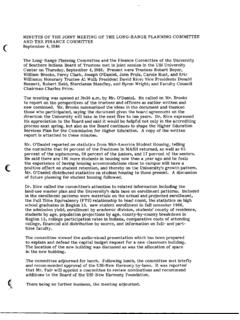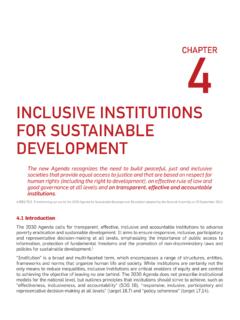Transcription of HISTORY OF GLOBAL ECONOMY - University of Southern …
1 Page 1 of 1 HISTORY OF GLOBAL ECONOMY We begin our discussion of the HISTORY of the GLOBAL ECONOMY with the following question. What has led to such strong differences across regions of the world? The quick and dirty answer is simply that the "West" developed first. Birth of Capitalism1 One can find examples of sustained economic growth throughout HISTORY , for example in the woolen industry in 13th century Flanders, and in 14th century Florence. Starting with the 11th century long distance trading flourished connecting thriving pockets of growth, between Venice and the Netherlands. However, by and large, living standards remained at subsistence levels for the majority of the world's population until the middle of the 18th century. Over the centuries as commerce grew, albeit slowly, the power of the vassals of the feudal system declined being replaced by merchants and incipient capitalists. Innovations in sailing led to long distance trading.
2 The opportunities and challenges of sending a vessel abroad for years at a time brought about the institutions which facilitated the growth of the modern capitalist system. Institutions which spurred the growth of capitalism Principle of Private Property Joint Stock Companies Deposit Banking Insurance Formal Contracts International Financial Markets Craft Guilds Government Support of Opening Markets Merchant Associations At the same time burgeoning industrialization and urbanization further weakened the feudal ECONOMY changing both the political as well as the economic structure of Europe. The question remains why in the west ? Some of the factors contributing to these changes were: 1) The Protestant Reformation - note that industrialization began in northern Europe. Protestant work ethic - fostered hard work, frugality, sobriety and efficiency, virtues which facilitated capitalism. Page 2 of 2 2) Rise of strong nation states - 16th through 19th century.
3 The rise of strong nation-states created conditions conducive to capitalism. It provided domestic markets free of barriers to trade, a uniform monetary system, contract and property laws, police and militia protection, as well as, basic transportation and communications infrastructure. Initially absolute monarchs wrested power from feudal lords and town authorities and consolidated territory into nation states. Eventually, as the power of capitalists and the middle class or bourgeoisie rose, the monarchs ceded power to a more representative structure. 3) The Enlightenment - during the 17th and 18th century there were great scientific and social advances. Discoveries of oxygen, electricity, calculus, among many other findings led to practical applications in agriculture and industry. This period laid the scientific foundation for the industrial revolution. Social thought as expounded by David Hume, Adam Smith and Thomas Jefferson stressed the rights and responsibilities of the individual.
4 This weakened the power of institutions such as the church and state, which had patronizing relationships with the masses. This liberal philosophy emphasizing freedom from arbitrary authority further led to the rise of the middle class and the overthrow of the landed gentry. It eventually led to political revolutions in not only in the United States, but also in England, Holland, and France. The profits earned by capitalist from international trade, and the flow of gold and silver from the Americas, financed the accumulation of capital that furthered reinforced industrialization and capitalism. Capitalism and Colonization Capitalism as an economic system spread beyond Europe, mainly to North America and Australia. One may ask why capitalism and new technologies did not spread elsewhere. One possible answer is that the indigenous peoples of North America and Australia were not particularly numerous as compared to other regions.
5 As the descendants of the English and French colonists grew in number and with new immigrant waves, primarily from Europe, the European population overwhelmed the indigenous Page 3 of 3 peoples who were (at best) pushed aside. The European immigrants using their skills and by acquiring technologies from their home countries embarked on creating new industries. However, in africa , the Indian Subcontinent, East Asia, and in Latin America the indigenous peoples were relatively numerous. Being greatly outnumbered, the colonist created an administrative structure, which encouraged or more likely coerced, the indigenous peoples to produce primary products for export to the home countries. These primary products were then transformed in the production process into manufactured goods, some of which were re-exported back to the colonies. Under these conditions there was little incentive to create new industries in these colonies.
6 Japan Japan proved to be an exception. Until the Meiji Restoration (1868) Japan was basically a closed society. Feudal structures and a strong caste system were the main characteristics of this island nation. Being isolated and having an insular culture, which mistrusted foreigners, the Japanese were caught unaware of the economic and military power of the Western nations when Admiral Perry sailed into Yokohama harbor. The Japanese, understanding their great disadvantage, began a frantic and zealous campaign to industrialize in the latter part of the 19th century. Borrowing western technologies, the Japanese managed to build steel industries, create a modern navy and in1906 defeat the Russians in a naval battle in the Sea of Japan. Britain s Decline The world ECONOMY during the 19th century was centered on Britain's early start in the industrial revolution. Current account surpluses led to the English Pound becoming the world s major currency and the gold standard was established creating a system of fixed exchange rates.
7 By the end of the century British foreign direct investment and the diffusion of technology spread industrial development to the European continent and North America leading to greater international competition. However, towards the end of the 19th Century Britain did not respond to new technological and managerial realities. Their dominance began to diminish. The advent of steel and chemical industries, which enjoy economies of scale, led to the creation of large corporations. The British maintained the status quo with small to medium size family Page 4 of 4 manufacturing industries. The US with its large and growing internal market was better placed to exploit these new industries. Twentieth Century At the beginning of the 20th century the GLOBAL ECONOMY was in turmoil. Financial crises were common. Policies to protect domestic industries such as tariff measures stifled trade. Political alliances in Europe divided the continent into two camps.
8 The assassination of Archduke Ferdinand in the Balkans sparked the century s first World War. The advent of technology in warfare had devastating effects. The machine gun, armored tanks, and the use of poisonous gas brought warfare to a new level of barbarity, shocking the world. In its aftermath, President Woodrow Wilson advocated a new-world order centered on the League of Nations. While grand in concept the political realities of the day made it ineffective. The cost of WWI to Britain resulted in the abandonment of the gold standard, a system of exchange rates backed by gold. The post WWI era was marked by a resurgence of economic prosperity, particularly in the United States. However, Germany saddled with reparations, payments to Allied powers (France in particular) for damages caused during the war faced devastating hardship. The Germany currency suffered a hyperinflation making it near worthless.
9 At the end of the 1920s Germany began to get back up on its economic feet. The US stock market crashed in 1929. Inappropriate policy responses led to the Great Depression. Its repercussions spread to Europe as competitive policies of trade protection and currency devaluations were implemented in vain attempts to protect domestic economies. The US Congress passed the Tariff Act of 1930, better known as the Smoot-Hawley Tariff Act. These measures raised tariffs on imports to an average of 50%. This "beggar thy neighbor" policy led to a vicious cycle of reciprocal tariffs and other restraints to trade. International trade came to a halt in the mid-1930s deepening and lengthening the Great Depression both here at home and abroad. Germany, resurfacing after a decade of deprivation, now faced a new economic challenge. Political turmoil ensued and the 1933 Germany elections saw the rise of the National Socialist Party headed by Adolf Hitler.
10 Embarking on a re-industrialization policy, the Nazis expanded their military capacity, built the famous Germany highway system, the Autobahn, and encouraged production of the peoples car, Volkswagen. Flexing their new Page 5 of 5 found military might Germany under the Nazis, invaded Czechoslovakia in 1937 and latter precipitated World War II with the invasion of Poland in 1939. Post-World War II In 1944 it became clear that the war was coming to an end, and the western Allied powers decided to again to attempt building a new world order. Meeting at the Mount Washington Hotel in Bretton Woods, New Hampshire, the US and English representatives, White and Keynes respectively, (yes, Keynes of the Keynesian Macromodel!) set out to create institutions so to prevent the reoccurrence of the conditions which led to WWII. They proposed the creation of three organizations, with each organization playing a role in the smooth functioning of GLOBAL ECONOMY .













